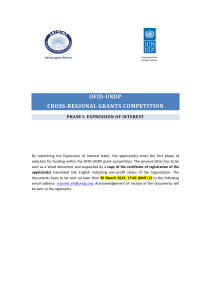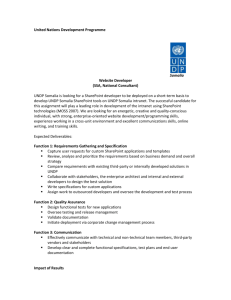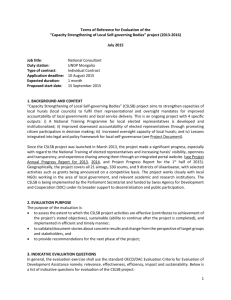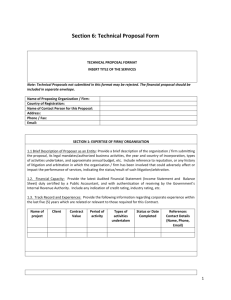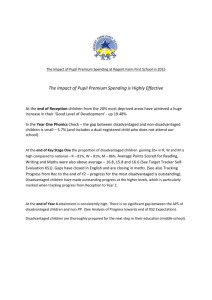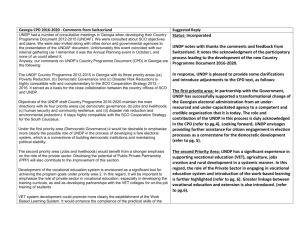GOVERNMENT OF INDIA – UNITED NATIONS
advertisement
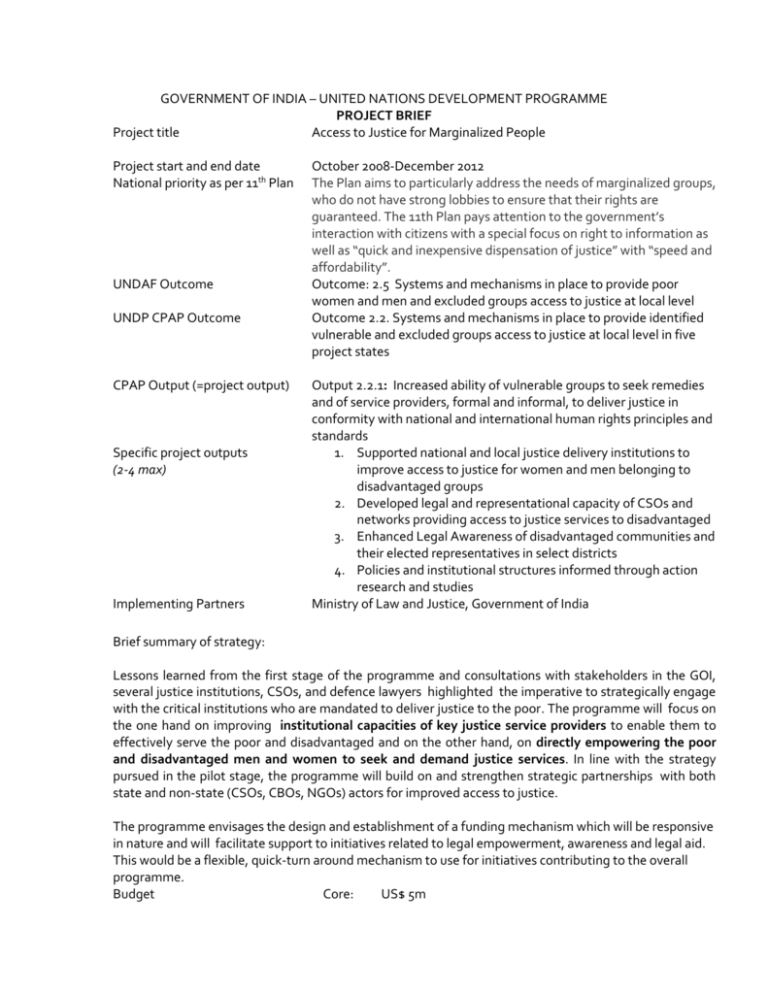
GOVERNMENT OF INDIA – UNITED NATIONS DEVELOPMENT PROGRAMME PROJECT BRIEF Project title Access to Justice for Marginalized People Project start and end date National priority as per 11th Plan UNDAF Outcome UNDP CPAP Outcome CPAP Output (=project output) Specific project outputs (2-4 max) Implementing Partners October 2008-December 2012 The Plan aims to particularly address the needs of marginalized groups, who do not have strong lobbies to ensure that their rights are guaranteed. The 11th Plan pays attention to the government’s interaction with citizens with a special focus on right to information as well as “quick and inexpensive dispensation of justice” with “speed and affordability”. Outcome: 2.5 Systems and mechanisms in place to provide poor women and men and excluded groups access to justice at local level Outcome 2.2. Systems and mechanisms in place to provide identified vulnerable and excluded groups access to justice at local level in five project states Output 2.2.1: Increased ability of vulnerable groups to seek remedies and of service providers, formal and informal, to deliver justice in conformity with national and international human rights principles and standards 1. Supported national and local justice delivery institutions to improve access to justice for women and men belonging to disadvantaged groups 2. Developed legal and representational capacity of CSOs and networks providing access to justice services to disadvantaged 3. Enhanced Legal Awareness of disadvantaged communities and their elected representatives in select districts 4. Policies and institutional structures informed through action research and studies Ministry of Law and Justice, Government of India Brief summary of strategy: Lessons learned from the first stage of the programme and consultations with stakeholders in the GOI, several justice institutions, CSOs, and defence lawyers highlighted the imperative to strategically engage with the critical institutions who are mandated to deliver justice to the poor. The programme will focus on the one hand on improving institutional capacities of key justice service providers to enable them to effectively serve the poor and disadvantaged and on the other hand, on directly empowering the poor and disadvantaged men and women to seek and demand justice services. In line with the strategy pursued in the pilot stage, the programme will build on and strengthen strategic partnerships with both state and non-state (CSOs, CBOs, NGOs) actors for improved access to justice. The programme envisages the design and establishment of a funding mechanism which will be responsive in nature and will facilitate support to initiatives related to legal empowerment, awareness and legal aid. This would be a flexible, quick-turn around mechanism to use for initiatives contributing to the overall programme. Budget Core: US$ 5m Non- Core: GOI: Approx. US$ 360,000 1. Situational Analysis Legal and Judicial System Access to justice is now recognized as being essential to human development, for ensuring democratic governance, in reducing poverty and for the purpose of conflict prevention. India’s judicial and legal system has many strengths: excellent constitutional and legal safeguards for access to justice; well-established institutions; a relatively independent and activist judiciary, a vibrant NGO sector and an independent media. The country has progressive laws in many areas such as the recognition of historical injustices, importance of group rights, positive discrimination for marginalized groups, including for women, and right to information. However, the system faces two main challenges: backlog leading to delays and limited access to justice. While an overloaded legal system negatively affects all persons, poor and marginalized groups are the worst affected. Government priorities in legal and judicial reform include improving the efficiency of the justice system and reducing backlog and delay. Legal Aid India’s legal and judicial system also provides legal aid services, including alternative dispute resolution for certain matters (known as Lok Adalats). Legal aid is a fundamental right in India and the Legal Services Authorities Act, 1987 (LSAA), provides for free legal aid to vulnerable groups. The statute institutionalized the system of legal aid delivery by setting up the National Legal Services Authority (NALSA) in 1995.1 NALSA has identified some major constraints in carrying out its mandate to the poor and disadvantaged women and men at the national, state and local levels including weak planning, budgeting and implementation capacities. Decentralisation of justice The need to de-centralize the formal judicial mechanisms is a priority in India as the formalities and centralized structures of the justice system place justice beyond the reach of rural poor. The proposed Gram Nyayalaya Bill, 2007 which is pending before the Parliament, if enacted will help to decentralise the judicial structure, make it more accessible to the marginalized sections of the population. There is however a need to carefully examine its provisions and also conduct some pilot programmes to carefully assess its impact on rural communities and within the justice delivery mechanism in general. Legal awareness 1 Similarly, state level units headed by the Chief Justice of each High Court were established, whilst at district level similar units were set up with District Judges as the heads of District Legal Services Committees. The committees are comprised of panels of lawyers who are required to provide legal aid and determine their remuneration, conduct legal awareness camps, organize lok adalats and prelitigation mediation and counseling and undertake visits to closed institutions like prisons and shelter homes. In many instances, poor and marginalised women and men are unable to seek the protection of the law or take advantage of rights or public services they are entitled to simply because they are unaware that they exist. In cases where they may be aware of the existence of the laws or rights, they may not be aware of how to use the law in order to claim or enforce their rights or entitlements.2 There is a clear recognition by the Government of India of its primary duty in ensuring legal awareness. State legal services authorities and NGOs are involved in a variety of legal literacy activities. However, increased public legal education and information initiatives are urgently needed and essential to improve access to justice for marginalized groups. The media, particularly community radio and television, are extremely useful tools for public legal information and education campaigns in both rural and urban areas. Further, it is important that sufficient legal information is able to reach the poor in forms that they are able to understand, digest and utilise. Programme Rationale UNDP defines Access to Justice as, “the ability of people to seek and obtain a remedy through the formal or informal institutions of justice, and in conformity with human rights standards”3 and recognizes that access to justice includes the ability to access the judicial system but has a broader scope than mere litigation. It is a right to live within an environment of rights where such rights are effectively protected. Within this broad paradigm, the term ‘access to justice’ includes two major concerns - guaranteeing human rights and ensuring capacity development of state institutions and citizens to ensure the protection of those rights.4 The results of the first phase of UNDP’s support to ‘Strengthened Access to Justice in India’ (SAJI I), have provided key and critical inputs into the design of a long-term programme of assistance in this area.5 One of the significant achievements of SAJI I is that it created networks of civil society groups which have been working at different levels in strengthening access to justice at the local level. The insights of these groups gained not only during the one year programme, but also during the preceding decades while they struggled with issues concerning the justice delivery mechanisms, were extremely important for designing a long term programme. For civil society groups, the partnerships with state functionaries at the district 2 In spite of several gender-related laws in India, there is an increasing record of crimes against women both inside the home and outside: wife beating, molestation, sexual abuse/harassment, rape, marital rape, incest, sexual assault, dowry deaths, foeticide, forced marriage, confinement, deprivation, trafficking, forced prostitution, etc. In cases of violence against women, particularly rape and dowry murders, the large number of acquittals are attributed not only to poor investigative machinery but also to lack of awareness and proper counseling of the victim prior to a trial. 3 UNDP, ‘Programming for Justice Access for All. A Practitioner’s Guide to a Human Rights-Based Approach to Access to Justice’, UNDP, Bangkok, 2005. p. 4 4 5 Ibid Strengthened Access to Justice in India (II): Design Mission Report, 5-16 May, 2008, Siphosami Malunga and Flavia Agnes. and state level proved to be extremely empowering as isolated efforts now had the potential of getting mainstreamed within the justice sector. The two-day National Roundtable on Access to Justice in December 2007 provided a useful platform for the Government of India (GOI), its partners and various other stakeholders to share their views and suggestions to improve legal aid services for the poor and strengthen justice delivery mechanisms in the country. The recommendations at the conclusion were exhaustive and dealt with various concerns and provided valuable insights for the current phase of the programme. The proposed Access to Justice programme is informed by the UNDP Strategic Plan, 2008-2011 which has the promotion of effective, responsive and accessible justice systems and the rule of law, including both formal and informal processes as a specific key result area. It is positioned within the over-arching objective of United Nations Development Assistance Framework (UNDAF) 2008-2012, of “promoting social, economic and political inclusion for the most disadvantaged, especially women and girls.” The formulation of the UNDAF was guided by the Millennium Development Goals (MDG) and the GOI’s Eleventh Five Year Plan. In line with the UNDAF, UNDP’s Country Programme Action Plan (CPAP) sets out as one outcome, the establishment of systems and mechanisms to provide poor women and men and excluded groups with access to justice at the local level in at least 5 states in India. Towards this outcome, the UNDP Country Programme will focus its efforts to increase the ability of vulnerable groups to seek remedies and of service providers to deliver justice in conformity with national and international human rights principles and standards. 2. Scope and Strategy The interventions under the Access to Justice programme will be focused on strengthening access to justice for the poor, particularly women, dalits, adivasis and minorities by supporting strategies and initiatives that seek to address the barriers they face in social, economic and political domains.6 In line with the UNDAF, interventions will be focused on the seven focus states .7 Lessons learned from the first stage of the programme and consultations with stakeholders in the GOI, several justice institutions, CSOs, and defence lawyers highlighted capacity challenges within justice institutions at national, state and local levels as a critical obstacle to ensuring access to justice. Clearly, therefore, there is an imperative to strategically engage with the critical institutions that are mandated to deliver justice to the poor to promote long-term and sustainable institutional reforms. The programme will focus on the one hand on improving institutional capacities of key justice service providers to enable them to effectively serve the poor and disadvantaged and on the other hand, on directly empowering the poor and disadvantaged men and women to seek and demand justice services. In this regard the programme will support and partner with national, state and local justice institutions including the judiciary, NALSA, civil society 6 Ibid p. 12 7 Bihar, Chattisgrah, Jharkhand, Madhya Pradesh, Orissa, Rajasthan and Uttar Pradesh organizations, professional bodies and academic institutions. The programme will also partner with quasi judicial bodies such as the human rights commissions, women commission, SC/ST commissions and minorities commissions, commissioner for persons with disabilities. In line with the strategy pursued in the pilot stage, the programme will build on and strengthen strategic partnerships with both state and non-state (CSOs, CBOs, NGOs) actors for improved access to justice. In order to optimize its impact, the programme will link with other UN programmes as well as other sectors within UNDP, to ensure that access to justice issues are taken into account in other programmes which focus on poor and marginalised women and men. In line with the modalities already tried and tested in the pilot stage, the programme envisages the design and establishment of a funding mechanism which will be responsive in nature and will facilitate support to initiatives related to legal empowerment, awareness and legal aid. This would be a flexible, quick-turn around mechanism to use for initiatives contributing to the overall programme including specific research on access to justice issues (e.g. victim compensation, gram nyayalaya etc.). Design of such a mechanism will define its management structure, including a review committee and will define clear parameters and criteria for support to initiatives. 3. Programme Deliverables 3.1 Supported national and local justice delivery institutions to improve access to justice for women and men belonging to the marginalised groups At the national level technical support will be provided to NALSA to improve its effectiveness to support state and district legal aid authorities in developing cost-effective operational and implementation strategies. This support is expected to address the lack of capacity of legal aid authorities at state and district levels to strategize, prepare action plans and budgets. The programme will facilitate a review or assessment of the challenges, capacities and opportunities faced by NALSA at the national, state and district level in providing services to the poor and disadvantaged. In order to support pro- poor justice policy reform, the programme will work closely with GoI and other stakeholders to develop and implement a system to monitor and evaluate the impact of the of the legal aid services on the poor and marginalized women and men. At the national level, the programme will support the Department of Justice to establish a platform bringing together the government, civil society organizations, lawyers, judges and other stakeholders. The needs and concerns of poor women and men from the scheduled castes, scheduled tribes and marginalized groups would be given priority by engaging with key institutions including (i) Tribes Advisory Council in States with Scheduled Tribes, (ii) National Commissions for SCs, (iii) National Commission for STs (iv) National Human Rights Commission, (v) the National Commission for Women, (vi) the National Commission for the Rights of Children (vii) National Commission for Minorities and (viii) Counterpart commissions in the States, (ix) Standing Parliamentary Committee on SC & ST. In order to influence judicial education and practice, at the national level it is proposed to collaborate with the National Judicial Academy in the creation of a knowledge sharing platform or mechanism, focused on sharing information between faculty of state judicial academies on cases advancing access to justice for the disadvantaged, including innovative lessons and judicial approaches. Documentation of jurisprudence from domestic and international law of cases relating to disadvantaged social groups will be undertaken and shared through such forums to enlarge the scope. 3.2 Developed legal and representational capacity of CSOs and networks providing access to justice services to disadvantaged groups Mapping studies and pilots under SAJI I worked with several individuals and organisations that operate at the local level. These organisations and individuals provide excellent opportunities to enhance access to justice at the local level where the poor and disadvantaged are located. They are also closely connected to these local communities and have a better understanding of the local cultural, political and legal dynamics. However, some of the challenges faced by these groups include lack of access to resources, lack of recognition by or access to public institutions, inadequate legal awareness or education, weak capacities to intervene on behalf of poor and disadvantaged. The Access to Justice programme will therefore strengthen the legal and representational capacity of select civil society and community based organisations, and networks, with a particular focus on enhanced awareness of laws, and legal procedures. The programme will facilitate the establishment and maintenance of channels for engagement between public institutions at the local level and the poor and disadvantaged or their intermediaries. It will support the establishment of platforms for interaction of vulnerable groups, civil society and state (panchayat) actors at the local level to identify emerging challenges faced by the poor and disadvantaged in accessing justice and by justice institutions in delivering justice services to the poor. 3.3 Enhanced Legal Awareness of women and men belonging to marginalized groups and their elected representatives in select districts A key objective of the programme will be to enhance legal awareness of women and men belonging to marginalized groups, particularly on the recent pro-poor legislations, fundamental rights to equality, freedom, liberty, right against torture and custodial abuse, right to life and livelihood, education and employment. The programme will support the identification of local CSOs, and CBOs for training/ Training of Trainers or awareness programmes The local panchayat leaders and networks of elected representatives will be the starting point for initiating these programmes in villages so that the culture of rights and entitlements is firmly entrenched within local governance bodies and spreads to the entire village community. Training programmes for local panchayat functionaries, committees of the panchayats including social justice committees, farmers groups, youth and women’s groups, anganwadi workers of ICDS programmes, and local school teachers will be designed and implemented. This will be done through state training institutions and through use of interactive media modes including radio and television, including community radio. Attention will be paid to ensuring that the legal content is accurate and addresses the needs of the community and are creative and innovative. This activity is expected to be coordinated closely with the Government of India/UNDP Decentralised Governance Programme and the Capacity Building for Local Governance Programme. At the national and state level, the programme will influence curriculum for human rights education in schools through advocacy and joint ministerial interaction involving Ministry of Human Resource Development, National and State Human Rights Commissions and Ministry of Justice. 3.4 Policies and institutional structures informed through action research and studies The GOI and several other stakeholders have highlighted the importance of well researched studies for justice policy analysis and reform. There is a need for independent research to evaluate the impact of the newer and proposed initiatives of the justice sector. Following up on SAJI I’s approach, the Access to Justice programme will facilitate engagement of institutions to undertake research on key access to justice issues. The aim of the research will be to bring to the notice of the Government lacunae within legislations and legal provisions which are adversely affecting the rights and entitlements of the vulnerable sections. This component will include partnership with National Commission for Women which has conducted studies of laws that adversely impact women. Similar studies for other marginalized population groups will be supported. The programme will support well designed and methodologically sound action research programmes which carefully monitor the impact of the new legislation and legal provisions that have been introduced or proposed to be introduced such as the Gram Nyayalaya Bill, Tribal Rights Bill etc. 4. Results & Resources Framework Intended Outcome as stated in the Country Programme Results and Resource Framework: 2.5. Systems and mechanisms in place to provide poor women and excluded groups access to justice at the local level. Outcome indicators as stated in the Country Programme Results and Resources Framework, including baseline and targets. 2.2. Systems and mechanisms in place to provide poor women and excluded groups access to justice at the local level in selected UNDAF states. Applicable Strategic Plan Key Result Area: Strengthening accountable and responsive governing institutions. Programme title and ID (ATLAS Award ID): Access to Justice for Marginalized People (49816 and Project ID 61113) Intended Outputs (as outlined in CPD/ CPAP) Increased ability of vulnerable groups to seek remedies and of service providers, formal and informal, to deliver justice in conformity with national and international human rights principles and standards Output Targets 1. Supported national and local justice delivery institutions to improve access to justice for women and men belonging to disadvantaged groups Indicative Activities (deliverables) 2008 1.1 Capacity assessment of NALSA conducted at national, select state and district levels conducted 1.2 Perception survey of poor women and men from marginalised groups to determine key Responsible parties UNDP; Department of Justice (GOI), CSO’s, CBO’s, academic institutions, private institutions Inputs Staff time Consultants Publications Training Workshops Equipment Consultant services Workshop facilitation, Printing & institutional bottlenecks for access to justice in sample districts in UNDAF states 2009 1.3 Inter-institutional platform established and roundtables held 1.4 Comprehensive capacity development strategy developed to address capacity gaps in NALSA, SALSA and District Committees 1.4 Enhanced NALSA capacity to plan, budget and manage legal aid provision with efficiency and increased reach to poor and disadvantaged groups at national, state and district levels. 1.5 Training packages for NALSA, SALSA and District Legal Service Committees permanent and temporary staff developed 1.6 Compilation and documentation of domestic and international case law on disadvantaged groups 1.7 Establishment of a sharing mechanism between National, State and local judicial academies 2010 1.6 Enhanced NALSA capacity to plan, budget and manage legal aid provision with efficiency and increased reach to poor and disadvantaged groups at national, state and district levels. 1.7 Technical and advisory services (management, planning, logistical, Regulations/ directives drafting…etc) provided to improve responsiveness of institutions to poor and disadvantaged 1.8 Legal awareness programmes on rights and access to justice, with a special focus on women’s rights, designed for select justice institutions (media groups, corporate sector), legal service providers, law enforcement agencies, government agencies and experts. Dissemination Costs Research Assistants Travel Grants Miscellaneous / operating costs Contracts 1.9 Awareness raising and sensitization of judiciary on rights of SC/ ST, women and disabled 2. Developed legal and representational capacity of CSOs and networks providing access to justice services to women and men belonging to disadvantaged groups 2009 2.1. Capacity gaps of legal assistance providers (CSOs, lawyers, law schools and CBOs) assessed in select districts. 2.2. Comprehensive capacity development programmes designed and implemented in select districts. 2010 2.3. Legal training, management, planning, budgeting and logistical skills provided to human rights defenders and groups in select districts. 2.4 Design district level platforms for interaction of vulnerable groups, civil society, human rights defenders and state (panchayat) actors at the local level to identify on an ongoing basis emerging challenges faced by the poor and disadvantaged in accessing justice and by justice institutions in delivering justice 2011 2.5 Establish district level platforms for interaction of vulnerable groups, civil society and state (panchayat) actors at the local level in select districts 3. Enhanced Legal Awareness of disadvantaged communities and their elected representatives in select districts 2008 3.1. Design of a funding mechanism with clear parameters and selection criteria 3.2 Responsible parties for the funding mechanism identified, including recruitment of fund manager and establishment of advisory/ selection committee 2009 3.3 Funding mechanism established to support legal awareness initiatives and to strengthen capacity of local CSOs, and networks supporting access to justice 3.4 Knowledge gaps on legal issues amongst select poor, disadvantaged groups identified in selected districts through surveys and assessments of legal awareness levels 3.5. Legal awareness programmes designed and implemented in X districts 3.6 TOT Training packages developed for CSOs to undertake legal awareness 2010 1. 3.7 Develop and disseminate relevant legal information (posters, leaflets, stickers, banners, air messages on Radio/ TV 2. 3.8 Establish a mechanism for joint ministerial/ departmental interaction on legal and rights education in schools 3. 3.9 Events for enhancing public awareness on legal issues organized using ICT 4. 3.10 Produce a Legal Awareness How To Guide/ Manual for use by CBOs/ CSOs 3.11 Knowledge gaps on legal issues affecting poor and disadvantaged groups, identified within select panchayats in X locations. 2011 3.12 Design of comprehensive and customized programmes to enhance capacities of local panchayats to address access to justice issues at local level 3.13 Mainstreamed access to justice training programmes for PRIs in state training institutions in UNDAF states 4. Policies and institutional structures informed through action research and studies 2009 4.1 Establish expert legal research team to identify themes for action research and studies to inform policy and institutional reform, guide and assess the research work 4.2 Commission action research and studies to identify lacunae in legislations and legal provisions which are adversely affecting the rights and entitlements of the vulnerable sections 2010 4.3 Share findings through dissemination events with policy makers, legislators, officials, justice sector officials 5. 5. Risks Assessment Risk Acceptance by Chief Justice of recommendation to partner with legal aid authorities Lack of support from States Category Regulatory Impact and Probability This will impact the design of one component (high impact, medium probability) Response Design team had intensive discussions with national authority to secure buy-in Political States may not be interested in working with the programme (medium impact, low probability) Effect of unrest in conflict prone districts on access to justice interventions Operational Security concerns may cause disruption in the delivery of legal awareness interventions (medium impact, low probability). Monitoring visits by UNDP staff may be prohibited due to security advisories. Consultations in initial phase with national and state governments In the selection of districts risks need to be assessed. Regular monitoring of risk required. Setting in place of a monitoring mechanism that can continue throughout periods with Staff hired under the programme as well as staff of responsible parties may be exposed to security risks. Slow delivery at State level Operational State level programme implementation may have slow delivery (medium impact, low risk) security advisories. Regular monitoring of risks required. Insurance options and requirements to be clearly stated in agreements with partners. Regular monitoring of delivery status by State coordinator with close oversight by Programme Officer 6. Management Arrangements Implementation Arrangements A Programme Management Board (PMB) for the Democratic Governance Programme Outcome (Outcome 2 in CPD/CPAP) will be set up and co-chaired by DEA and UNDP. The PMB will oversee the delivery and achievement of results for all the initiatives under the Democratic Governance Programme Outcome and provide strategic direction for future programmes in this Outcome area. The PMB will also appraise the new programme initiatives prior to sign off with the Implementing Partners (IPs). The PMB will comprise ministries relevant to the Programme Outcome and relevant stakeholders identified in consultation with UNDP and Implementing Partners. It will meet twice a year, in the 2nd and 4th quarter, to take stock of the physical and financial progress. Potential Implementing Partners: The programme will be anchored with the Department of Justice (DoJ), Ministry of Law and Justice, Government of India which will be designated as Implementing Partner (IP). The DoJ will designate a National Project Director (NPD), who will be responsible for overall management, including achievement of planned results, and for the use of UNDP funds through effective process management and well established programme review and oversight mechanisms. The Implementing Partner will sign a budgeted Annual Work Plan with UNDP on an annual basis, as per UNDP rules and regulations. The Implementing Partner will designate an official or hire on project funds a Project Manager and set up a Project Management Team which will be headed by the Project Manager. The Project Manager will be responsible for the day-to-day management of the programme. S/he will coordinate the Project activities including the preparation of Annual and Quarterly Work Plans, Budget, Financial Reports, etc. and will interface on project management issues. Responsible Parties: To achieve programme results, partners will be identified for achieving specific programme results. These will be designated as Responsible Parties and could be other government or quasi-government departments/ institutions, state governments, civil society organizations (CSOs), or UN agencies. The IP will sub-contract institutions/organizations or procure the services of consultants to ensure proper implementation of programme activities. Procurement of services from “Responsible Party (ies) will be through capacity assessment and a process of competitive bidding to undertake specific tasks linked to programme outputs carried out under the overall guidance of the Programme Steering Committee. If the entity short-listed is another Government Institution or a UN Agency, the process of selection of the Responsible Party (ies) will be carried out through appropriate capacity assessment and appraisal processes. Notwithstanding, the contracting arrangements will be fully documented and endorsed by the Programme Steering Committee. Project Steering Committee: A Project Steering Committee (PSC) will be set up under the project. It will be chaired by the NPD and comprise designated representatives from the DoJ, UNDP including the Additional Secretary of the Ministry of Law and Justice (DOJ)- Chairperson, Joint Secretary, DoJ, State Government representatives, UNDP Governance Programme Head, Project Manager and select experts. The PSC will: Ensure that programme goals and objectives are achieved in the defined timeframe; Review programme progress and suggest implementation strategies periodically; Review programme expenditures against activities and outcomes; and Approve Annual and Quarterly Work Plans. The PSC will be the group responsible for making, by consensus, management decisions for the project and holding periodic reviews. In order to ensure UNDP’s ultimate accountability, the final decision making rests with UNDP in accordance with its applicable regulations, rules, policies and procedures. Project reviews by the PSC will be carried out on a quarterly basis during the running of the project, or as necessary when raised by the Project Manager. Project Management Team (PMT): The PMT headed by a Project Manager will be established under the project. The Project Manager will be responsible for day-to-day management; monitoring and review of project activities; coordination with Responsible Party (ies) and different stakeholders and; decision making and will be accountable to the NPD and PSC. S/he will prepare the detailed activity and monitoring plan based on the Annual Work Plan (AWP) and Budget and submit it to the PSC for approval. The Project Manager will ensure that the project produces the results specified in the project document, to the required standards of quality and within specified constraints of time and cost. The Project Manager will be assisted by a PMT: (a) full time Project Officer with substantial experience in legal aid and legal empowerment (b) a Monitoring, Evaluation, and Documentation Officer, and (c) an Administrative Assistant. Services of a Gender and Social Inclusion Specialist will be procured on an as-required basis. Recruitment of state level project support will be considered in consultation with IP. The recruitment and staffing process will give due attention to considerations of gender equality and promoting diversity at workplace. Along with the Project Manager, the PMT will be based at the DoJ and if agreed otherwise, alternative arrangements will be made and charged to the project. Project Assurance: Project Assurance will be the responsibility of UNDP. The Assurance role will support the PSC by carrying out objective and independent project oversight and monitoring functions. During the implementation of the project, this role ensures (through periodic monitoring, assessment and evaluations) that appropriate project management milestones are managed and completed. NPD, in collaboration with the Project Manager, will convene an annual review meeting involving the Implementing Partner and Responsible Parties to review the progress in the previous year and discuss the work plan for the coming year. An independent external review may be conducted through resource persons/groups to feed into this process. Programme Assurance and Project Manager will meet quarterly (or whenever guidance/decision is required by an implementing agency). Funds Flow Arrangements and Financial Management: The Department of Justice will account for funds received from UNDP as per the signed AWP. It may request UNDP to proceed directly with payments to Responsible Parties on its behalf on a quarterly basis through the standard Fund Authorization and Certificate of Expenditures (FACE) Report. The Project Manager will be responsible for compilation and collation of these Financial Reports. Unspent funds from the approved AWPs will be reviewed in the early part of the last quarter of the calendar year and funds reallocated accordingly. The detailed UNDP financial guidelines will be provided on signature of the programme. The DoJ may enter into an agreement with UNDP for the provision of implementation support services (ISS) by UNDP in the form of procurement of goods and services. Cost recovery for ISS will be charged as per UNDP rules and regulations and the details will be outlined in the budgeted AWP for each year. 1% of the total programme budget will be allocated for communication and advocacy activities undertaken by UNDP. Interest Clause: A separate Savings Bank Account will be opened in the name of the project and any interest accrued on the project money during the project cycle will be ploughed back into the project in consultation with the DoJ and UNDP and project budget will stand revised to this extent. In case there is no scope for ploughing back, the interest will be refunded to UNDP. Audit: The project shall be subject to audit in accordance with UNDP procedures and as per the annual audit plan drawn up in consultation with DEA. The project shall be informed of the audit requirements by January of the following year. The audit covering annual calendar year expenditure will focus on the following parameters – (a) financial accounting, documenting and reporting; (b) monitoring, valuation and reporting; (c) use and control of non-extendable reporting; (d) UNDP Country Office support. In line with the UN Audit Board requirements for submitting the final audit reports by 30 April, the auditors will carry out field visits during February/March. Detailed instructions on audit will be circulated by UNDP separately and on signature. 7. Monitoring & Evaluation A monitoring and evaluation system will be established to track the project’s progress. It will also help identify lessons and good practices with potential for policy advocacy and replication/scaling up in other states/regions. The monitoring tools used will promote learning (including identification of factors that impede the achievement of outputs). Such learning will be used to adapt strategies accordingly and avoid repeating mistakes from the past. ICTs will be used to provide easily accessible information to various stakeholders. The DoJ will have the overall responsibility of monitoring the project, in line with the roles and responsibilities described above and through regular monitoring visits and quarterly review meetings by the PSC. The Project Manager will be responsible for day-to-day monitoring of project activities through periodic field visits, interactions with state level programme teams/partners and desk reviews. He/she will also prepare and submit periodic progress reports to the PSC. Monitoring will be an on-going process and mid-course corrections will be made if required. An annual project review will be conducted during the 4th quarter of each year to assess the performance of the project and the extent to which progress is being made towards outputs, and ensure that these remain aligned to relevant outcomes. Based on the status of project progress, the Project Manager will prepare an Annual Work Plan for the subsequent year which will be discussed and approved at the annual review meeting. In addition, UNDP will commission a mid-term project review and annual management and financial audit during the project period. In the last year, the annual review will be the final evaluation of the project and this will involve all key project stakeholders. A variety of formal and informal monitoring tools and mechanisms should be used by the Project Management Team. This would include field visits as well as reports in standard UNDP formats and as per UNDP’s web-based programme management system (ATLAS). Within the annual cycle, the Project Manager in consultation with the NPD and UNDP will ensure quarterly review and reporting. 8. Legal Context This document together with the CPAP signed by the Government and UNDP which is incorporated by reference constitute together the instrument envisaged in the Supplemental Provisions to the Project Document, attached hereto (Annexure V). Consistent with Supplemental Provisions, the responsibility for safety and security of the IP and its personnel and property, and of UNDP’s property in the implementing partner’s custody, rests with the implementing partner. The implementing partner shall: put in place an appropriate security plan and maintain the security plan, taking into account the security situation in the country where the project is being carried; assume all risks and liabilities related to the implementing partner’s security, and the full implementation of the security plan. UNDP reserves the right to verify whether such a plan is in place, and to suggest modifications to the plan when necessary. Failure to maintain and implement an appropriate security plan as required hereunder shall be deemed a breach of this agreement. The implementing partner agrees to undertake all reasonable efforts to ensure that none of the UNDP funds received pursuant to the Project Document are used to provide support to individuals or entities associated with terrorism and that the recipients of any amounts provided by UNDP hereunder do not appear on the list maintained by the Security Council Committee established pursuant to resolution 1267 (1999). This provision must be included in all sub-contracts or sub-agreements entered into under this Project Document. 9. Budget UNDP will contribute US $5,000,000.00 from its core resources. The Government of India’s contribution will be approx. USD 360,000, and time dedicated by the Department of Justice and other in-kind contributions provided at the national, state and local levels. It is envisaged that during implementation, there may be need for scaling up, deepening and widening activities and therefore additional resources. In such a case, additional resources will be mobilized. Expected Output Supported national and local justice delivery institutions to improve access to justice for women and men belonging to disadvantaged groups Subtotal Developed legal and representational capacity of CSOs and networks providing access to justice services to women and men belonging to disadvantaged groups Subtotal Enhanced Legal Awareness of Key Activities and Deliverables Capacity assessment of NALSA, SALSA and District Legal Aid Authorities Perception Survey Comprehensive capacity development strategy developed Enhanced NALSA, SALSA and District Authorities' capacity to plan, budget and manage legal aid provision I Inter-institutional platform/ roundtables Technical and advisory services provided Support to NJA – Case law documentation and sharing mechanism Account Code 72100 Budget Description Contractual Services – Companies Amount (USD) 75,000 72100 72100 Contractual Services Contractual Services – Companies 72100 Contractual Services 600,000 72100 Contractual Services – Companies Contractual Services – Companies Contractual Services 280,000 72100 72100 Capacity gaps of legal assistance providers Comprehensive capacity development programmes designed Technical and advisory services 72100 Build capacity of human rights defenders from community 72100 Establish district level platforms in select districts 72100 Contractual Services – Companies Establishment of a funding mechanism 72100 Contractual Services – Companies 72100 72100 Contractual Services – Companies Contractual Services – Companies Contractual Services – Companies Contractual Services – Companies 25,000 25,000 25,000 100,000 1,130,000 25,000 250,000 25,000 600,000 200,000 1,100,000 25,000 disadvantaged communities and their elected representatives in select districts Subtotal Policies and institutional structures informed through action research and studies Subtotal Programme monitoring, evaluation and capacity development Subtotal GRAND TOTAL Knowledge gaps on legal issues amongst select poor, disadvantaged groups identified in selected districts and panchayats Comprehensive legal awareness programmes designed and implemented Develop and disseminate relevant legal information 72100 Contractual Services – Companies 50,000 72100 Contractual Services – Companies 700,000 72100 Communication 400,000 Establish a mechanism for joint ministerial/ departmental interaction on legal and rights education in schools 72100 Contractual Services – Companies 150,000 Commission action research and studies Share findings through dissemination events with policy makers, legislators, officials, justice sector officials 72100 74500 Salaries of national and state programme management team incl. fund manager State Coordinators Monitoring travel cost ISS Office Communication (1%) Miscellaneous 71400 71500 71600 74500 72100 74500 Audit 74100 Contractual Services – Companies Miscellaneous (Workshop) Contractual Services Individual Travel Miscellaneous Operating Expenses Miscellaneous Professional Services 1,325,000 150,000 375,000 525,000 500,000 67,500 100,000 45,000 50,000 107,500 50,000 920,000 5,000,000



